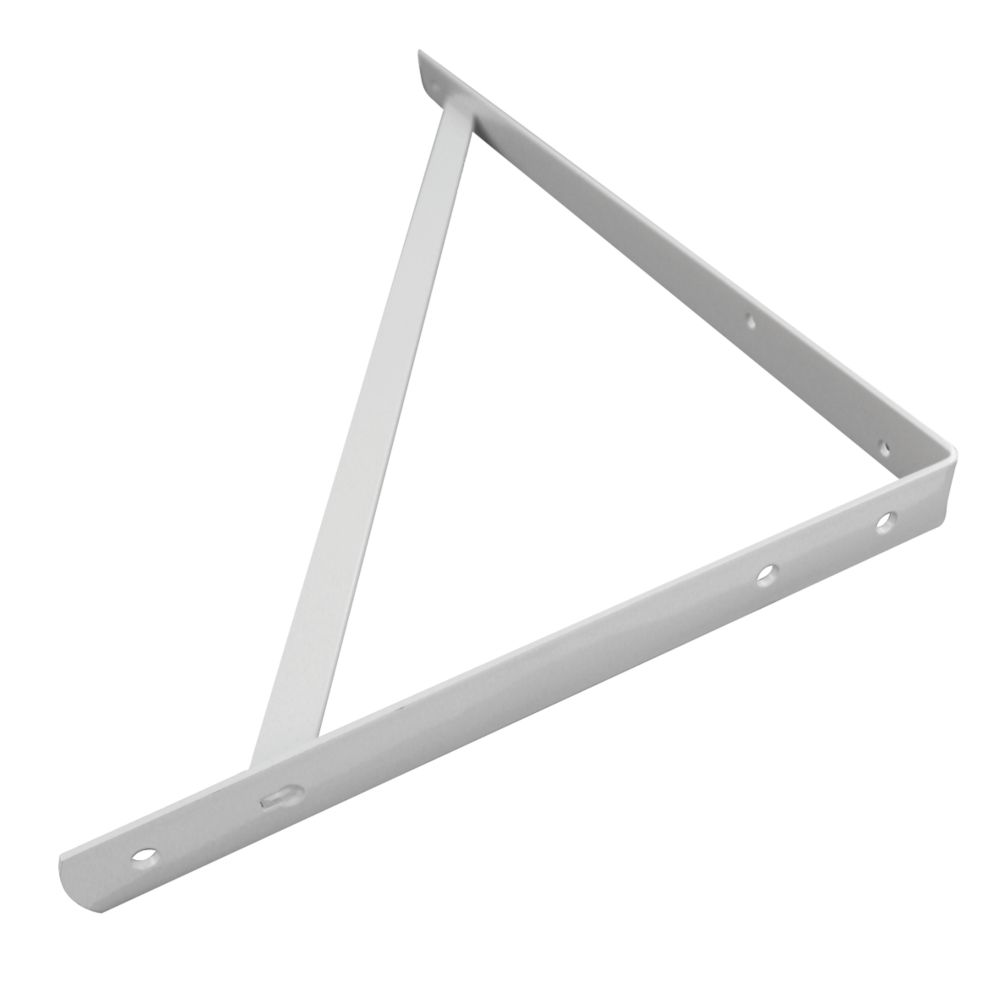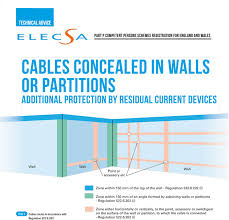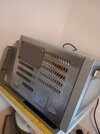It will be nice when it’s finished
You are using an out of date browser. It may not display this or other websites correctly.
You should upgrade or use an alternative browser.
You should upgrade or use an alternative browser.
Raised Shelf for Heavy Microwave (Ed.)
- Thread starter Keitai
- Start date
Sponsored Links
A single shelf is not ideal for a heavy item, as the leverage on the fixings will be extreme.
I have a combi microwave in a wall cabinet, enabling the hanging points to be well above. Somewhat similar to the American kitchen shown. Above the microwave is another compartment, currently holding plates and glasses. The one beside it holds large items such as rolls of foil and clingfilm and is the same depth so it looks better. The cavity is larger than the oven and has ventilation.
Mine is hung on cabinet hanging rail, which is very strong and runs all along the wall.
The cabinet carcase was ordered as "boiler cabinet " which is deeper than common wall cabinet. I think it is 500mm deep rather than the usual 300mm, and is 600mm wide. Mine is 900mm high to match the rest of the kitchen.
It is much prettier than Keitai's.
I have a combi microwave in a wall cabinet, enabling the hanging points to be well above. Somewhat similar to the American kitchen shown. Above the microwave is another compartment, currently holding plates and glasses. The one beside it holds large items such as rolls of foil and clingfilm and is the same depth so it looks better. The cavity is larger than the oven and has ventilation.
Mine is hung on cabinet hanging rail, which is very strong and runs all along the wall.
The cabinet carcase was ordered as "boiler cabinet " which is deeper than common wall cabinet. I think it is 500mm deep rather than the usual 300mm, and is 600mm wide. Mine is 900mm high to match the rest of the kitchen.
It is much prettier than Keitai's.
come on people
people's brains are wired up differently
what seems obvious to some will be impossible to others
ridiculing something rather than helping shows a lack off understanding
as we are all helpful people here i will assume most will have learnt from this thread ---as my tag line says
people's brains are wired up differently
what seems obvious to some will be impossible to others
ridiculing something rather than helping shows a lack off understanding
as we are all helpful people here i will assume most will have learnt from this thread ---as my tag line says
Come on big-all, a chunk of wood sat on the appliance underneath, nobody would seriously think that was OK, I don't believe it.
Sponsored Links
if you are worried double up on thickness
or at least the outside leg which incidently could be 2x1if you wish lining up with the foot a near as possible to give most support
Leg off the corner of the shelf onto work surface 2 x1 or your shelf bracket- https://images-na.ssl-images-amazon.com/images/I/61hjnmm3sNL._AC_SL1500_.jpg
It might hold lighter microwave floating without leg and put combi microwave underneath. Wanted bigger one off worktop though
Or shall I just give up on this?
Isn't this that lol?Can you get a really good fixing into the wall, I.e direct into brickwork?
If so, heavy duty battens and a thick shelf material should sort it.....I don’t suppose a vertical peg leg would be possible?
John
Something like this, but installed upside down. Suspending the shelf.
Machine screw and washer/nut on the bottom section.

 www.screwfix.com
www.screwfix.com
Machine screw and washer/nut on the bottom section.

Heavy Duty Industrial Shelf Brackets White 295mm x 210mm 2 Pack - Screwfix
Order online at Screwfix.com. Contemporary load-bearing brackets for heavier jobs around the home, garage and workplace. FREE next day delivery available, free collection in 1 minute.
Something like this, but installed upside down. Suspending the shelf.
Machine screw and washer/nut on the bottom section.
These, are made for the job, and fold back to the wall when not in use...
all i am saying in his mind that's ok he hasn't learnt it's not a good idea yet---- well he has nowCome on big-all, a chunk of wood sat on the appliance underneath, nobody would seriously think that was OK, I don't believe it.
the more you stop people asking questions the less they learn
- Joined
- 7 Sep 2022
- Messages
- 2,736
- Reaction score
- 697
- Country

Jesus wept. Please tell me that's not actually your test of where to drill into a wall that contains electrical accessories?Electrics usually run down so what's the issue?
Everything you can see related to electrics on a wall, be it a socket, switch, fused outlet, blanking panel, wall light etc etc creates a + shaped "danger zone" centred on it and running the full width/height of that wall face until it reaches a corner. There is also by default a "danger zone" emanating 6 inches away from every corner (including at the ceiling corner) in either direction, on walls
I've called them danger zones despite the official name being electrical safe zones because the official name is related to keeping the wires safe, not you. Drilling into any of these zones without first having checked whether they contain wires represents a danger to your life and a danger to the house user's life (because you could easily just nick a cable and put a screw into just the live core, making the screw live to the touch). It's not enough to just turn the electrics off for this same reason (of creating live screws/brackets etc)
Buy a detector and learn how to use it please

---
Separately to the Darwin Award entry application, I think it would have looked better if you'd obtained a length of kitchen worktop, cut it so it was a triangle and mounted across the corner to sufficient depth that the microwave would sit at an angle, and also drilled a hole large enough to admit a uk plug, right at the back behind the microwave so that the wire could be fed through the hole at the back of the shelf and down into a socket rather than being trailed over the front edge:
Triangle shelf, microwave in yellow, wire in blue
A short section of white trunking going mostly down to the worktop would also have helped neaten the job up. Worktop material would be strong enough to support the load without additional support but care should be taken to waterproof the underside if placing a kettle under it as steam would gradually bow/delaminate, and eventually ruin, the shelf
Last edited:
Thxs for diagrams above on safe zones. Used a detector and couldnt find any voltage above the electrical sockets etc on worktop. But just in case no screws were put directly above any socket or other electric thing. One of the walls is an internal and there's a electric socket the other side. 1970's flat, I guess brickJesus wept. Please tell me that's not actually your test of where to drill into a wall that contains electrical accessories?
Everything you can see related to electrics on a wall, be it a socket, switch, fused outlet, blanking panel, wall light etc etc creates a + shaped "danger zone" centred on it and running the full width/height of that wall face until it reaches a corner. There is also by default a "danger zone" emanating 6 inches away from every corner (including at the ceiling corner) in either direction, on walls
I've called them danger zones despite the official name being electrical safe zones because the official name is related to keeping the wires safe, not you. Drilling into any of these zones without first having checked whether they contain wires represents a danger to your life and a danger to the house user's life (because you could easily just nick a cable and put a screw into just the live core, making the screw live to the touch). It's not enough to just turn the electrics off for this same reason (of creating live screws/brackets etc)
Buy a detector and learn how to use it please

---
Separately to the Darwin Award entry application, I think it would have looked better if you'd obtained a length of kitchen worktop, cut it so it was a triangle and mounted across the corner to sufficient depth that the microwave would sit at an angle, and also drilled a hole large enough to admit a uk plug, right at the back behind the microwave so that the wire could be fed through the hole at the back of the shelf and down into a socket rather than being trailed over the front edge:
View attachment 338305
Triangle shelf, microwave in yellow, wire in blue
A short section of white trunking going mostly down to the worktop would also have helped neaten the job up. Worktop material would be strong enough to support the load without additional support but care should be taken to waterproof the underside if placing a kettle under it as steam would gradually bow/delaminate, and eventually ruin, the shelf

Yes I did put screws into the corners. I didn't know about wires being there too. Detector found nothing. When i used the detector basically press electric setting on detector and move around on wall. I know theyre not 100% though. Red means electricity found, green not found.
It's the top flat on two storeys. Why would electrics run up to the ceiling (flat roof) above anyhow? I've seen cables loose on floor under and behind the sink cabinets surely run down?
Tried your idea of the shelf going diagonally but this combi microwave thing is massive and it would jut out massively. Might just put smaller normal microwave on it. Gonna drill a hole as you said in back of shelf to push plug down.
Last edited:
- Joined
- 7 Sep 2022
- Messages
- 2,736
- Reaction score
- 697
- Country

Good stuff on the detector, though I have to say a bit of a shocking colour choice from Bosch there given that 10% of males exhibit some form of colour "blindness"/difficulty discerning red / green.
And in an industry that ought to be more aware given that it was one of the reasons for switching away from red/black electrical core colours to brown/blue
Not your problem though, just surprising. I think that's a real ball-drop on Bosch's part
And in an industry that ought to be more aware given that it was one of the reasons for switching away from red/black electrical core colours to brown/blue
Not your problem though, just surprising. I think that's a real ball-drop on Bosch's part
Good stuff on the detector, though I have to say a bit of a shocking colour choice from Bosch there given that 10% of males exhibit some form of colour "blindness"/difficulty discerning red / green.
Colour blindness, always used to be one of the first checks, when considering a carer in the electrical industry.
These, are made for the job, and fold back to the wall when not in use...
Bought these. Dunno if they're big enough for combi microwave.
Attachments
Last edited:
DIYnot Local
Staff member
If you need to find a tradesperson to get your job done, please try our local search below, or if you are doing it yourself you can find suppliers local to you.
Select the supplier or trade you require, enter your location to begin your search.
Please select a service and enter a location to continue...
Are you a trade or supplier? You can create your listing free at DIYnot Local
Sponsored Links

